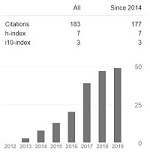Anomali pengaruh sektor industri terhadap tingkat kemiskinan di Indonesia
Sari
Kontribusi sektor industri terhadap perekonomian yang cenderung menurun, juga diikuti dengan penurunan kemiskinan dalam pengamatan yang cukup panjang. Tren yang searah ini menjadi salah satu pemantik untuk menelusuri lebih dalam pengaruh sektor industri, dan beberapa variabel prediktor lainnya terhadap kemiskinan. tujuan dari penelitian ini adalah untuk menganalisis pengaruh jangka pendek dan jangka panjang dari sektor industri, pertanian, konsumsi rumah tangga, konsumsi pemerintah, dan PMTB terhadap tingkat kemiskinan di Indonesia tahun 2000-2021. Data diperoleh dari publikasi BPS, dengan metode analisis desktriptif kuantitatif dengan pendekatan Error Correction Model. Berdasarkan uji derajat integrasi diketahui bahwa data stasioner pada orde kedua. Pengujian residual Engle-Granger memperoleh hasil bahwa data pada tingkat level terdapat kointegrasi. Hasil regresi pada sektor industri justru menunjukkan pengaruh yang positif signifikan baik dalam jangka panjang maupun jangka pendek. Konsumsi rumah tangga berpengaruh negatif baik jangka panjang maupun jangka pendek. Kemudian, PMTB memiliki pengaruh signifikan dalam jangka pendek, namun semakin melemah dalam jangka panjang. Sedangkan konsumsi pemerintah dan sektor pertanian tidak berpengaruh signifikan terhadap tingkat kemiskinan di Indonesia.
The contribution of the industrial sector to the economy which tends to decline, is also followed by a decrease in poverty in a long period of observation. This unidirectional trend is one of the triggers to explore more deeply the influence of the industrial sector, and several other predictor variables on poverty. The purpose of this study is to analyze the short-term and long-term effects of the industrial sector, agriculture, household consumption, government consumption, and PMTB on the poverty rate in Indonesia in 2000-2021. Data obtained from BPS publications, using quantitative descriptive analysis method with Error Correction Model approach. The regression results in the industrial sector actually show a significant positive effect both in the long and short term. Household consumption has a negative effect both in the long and short term. Then, PMTB has a significant effect in the short term, but weakens in the long term. Meanwhile, government consumption and the agricultural sector have no significant effect on the poverty rate in Indonesia.
Kata Kunci
Teks Lengkap:
PDFReferensi
Armelly, A., Rusdi, M., & Pasaribu, E. (2021). Analisis sektor unggulan perekonomian Indonesia: Model input-output. Sorot, 16(2), 119-134. https://doi.org/10.31258/sorot.16.2.119-134
Badan Pusat Statistik. (2022). Statistik Indonesia. Tersedia di https://www.bps.go.id/publication/2022/02/25/0a2afea4fab72a5d052cb315/statistik-indonesia-2022.html, diakses pada Mei 2022.
Datt, G., Ravallion, M., & Murgai, R. (2016). Growth, Urbanization, and Poverty Reduction in India. Growth, Urbanization, and Poverty Reduction in India, February. https://doi.org/10.1596/1813-9450-7568
Efendi, R., Indartono, S., & Sukidjo, S. (2019). The Relationship of Indonesia’s Poverty Rate Based on Economic Growth, Health, and Education. International Journal of Multicultural and Multireligious Understanding, 6(2), 323. https://doi.org/10.18415/ijmmu.v6i2.704
Ekananda, M. (2016). Analisis Ekonometrika TIme Series. Mitra Wacana Medika.
Ginantie, B. & S. D. B. (2016). Analisis Dampak Sektor Pertanian Terhadap Kemiskinan Jawa Timur. Jurnal Ilmiah Mahasiswa FEB Universitas Brawijaya, 5(1), 1–17.
Handoyo, F., Hidayatina, A., & Purwanto, P. (2021). The Effect of Rural Development on Poverty Gap, Poverty Severity and Local Economic Growth in Indonesia. Jurnal Bina Praja, 13(3), 369–381. https://doi.org/10.21787/jbp.13.2021.369-381
LIU, M. yue, FENG, X. long, WANG, S. gui, & ZHONG, Y. (2021). Does poverty-alleviation-based industry development improve farmers’ livelihood capital? Journal of Integrative Agriculture, 20(4), 915–926. https://doi.org/10.1016/S2095-3119(20)63449-9
Niara, A., & Zulfa, A. (2019). Pengaruh Kontribusi Sektor Pertanian dan Industri Terhadap Kemiskinan Di Kabupaten Aceh Utara. Jurnal Ekonomi Regional Unimal, 02(01), 28–36. url: http://ojs.unimal.ac.id/index.php/ekonomi_regional
Pham, T. H., & Riedel, J. (2019). Impacts of the sectoral composition of growth on poverty reduction in Vietnam. Journal of Economics and Development, 21(2), 213–222. https://doi.org/10.1108/jed-10-2019-0046
Pratama, N. R. N. S., & Utama, M. S. (2019). Pengaruh Pengeluaran Pemerintah Dan Investasi Terhadap Pertumbuhan Ekonomi Dan Tingkat Kemiskinan di Kabupaten/Kota Provinsi Bali. E-Jurnal Ekonomi Dan Bisnis Universitas Udayana, 8 [7](2337–3067), 651–680.
Primadi, Y. A. (2019). Analisis Dampak Industrialisasi Terhadap Kemiskinan di Jawa Timur. Jurnal Ilmiah Mahasiswa FEB Universitas Brawijaya, 5(1), 1–15.
Rustiadi, E. et al. (2009). Perencanaan dan Pengembangan Wilayah. Yayasan Obor Indonesia.
Solow, R. (1956). A Contribution to the Theory of Economic Growth. Journal of Economics, 70(1), 65–94.
DOI: http://dx.doi.org/10.31258/sorot.17.2.91-103
Refbacks
- Saat ini tidak ada refbacks.
##submission.copyrightStatement##
##submission.license.cc.by4.footer##
Hak cipta artikel-artikel pada jurnal ini dimiliki oleh penulis, dan penulis bersedia memberikan hak penerbitan pertama kepada jurnal. Pemilikan hak cipta dilisensikan dibawah Creative Commons Attribution 4.0 International License. Lisensi ini memungkinkan penggunaan, pendistribusian, dan pencetakan kembali tanpa batas pada media apa pun, asalkan penulis dan sumber sebenarnya disebutkan.





